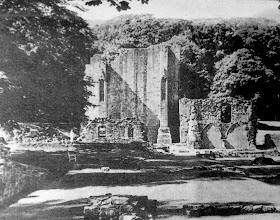Winter 1940 and snow falls across the Furness Peninsula. The snow keeps falling, heavily, creating large snow drifts, blocking up doors and windows, preventing the use of roads and freezing ponds, rivers and even the sea! This was some of the worst snow the area had seen in recent memory.
 "A perfectly unbelievable day! My husband could not open the garage door on the side of the house, and had to get out the dining-room window and dig four feet of snow from the back door - which opens outwards. Poor old Mr. Murphy* took a leap onto the garden and disappeared - and instead of keeping still, started to tunnel his way madly under the snow. Talk about 'lost in a fog'!" - Nella Last, 1940; Nella Last's War. *Mr. Murphy was a cat.
"A perfectly unbelievable day! My husband could not open the garage door on the side of the house, and had to get out the dining-room window and dig four feet of snow from the back door - which opens outwards. Poor old Mr. Murphy* took a leap onto the garden and disappeared - and instead of keeping still, started to tunnel his way madly under the snow. Talk about 'lost in a fog'!" - Nella Last, 1940; Nella Last's War. *Mr. Murphy was a cat.Whilst War began across Europe the people back home in Furness were up against a different kind of battle, one against the elements!
 It was the first year of World War 2, rationing had just been introduced across the country and the worst snow fall of the recent times had fallen. As can be seen in the picture above and to the right the snow grew to large heights covering over doors preventing them from being opened. The picture above shows a dug out shelter in Barrow Park and right shows Dalton Road with the snow piled up at either side of the road. The snow at this time was hardly reported in newspapers for fear of letting the Germans know that the country was at a near standstill.
It was the first year of World War 2, rationing had just been introduced across the country and the worst snow fall of the recent times had fallen. As can be seen in the picture above and to the right the snow grew to large heights covering over doors preventing them from being opened. The picture above shows a dug out shelter in Barrow Park and right shows Dalton Road with the snow piled up at either side of the road. The snow at this time was hardly reported in newspapers for fear of letting the Germans know that the country was at a near standstill."All that is talked about is that the snow has brought most of the industry in the North and Midlands to a stop. Road transport is at a virtual standstill. The railway lines and tunnels are so blocked up they have to dig them out." Says Lilian Ryan who wrote her memories of the war in a book called 'Cos That's The Way It Was: A Child's Eye View of Wartime Barrow'. She also states that "Some people in villages near us are getting short of food and their pipes are so frozen up they have to boil snow to cook with."
 |
| Coast Road bus Snowed in at Aldingham |
"All of Morecambe Bay stretched a frozen waste and, far across, Morecambe itself looked as if it might be able to be reached on foot. The water had not frozen flat like water but, as it dashed on to any stone, had frozen in a smother like spun of sugar." States Nella Last in her War Time Diaries. It is not often that the sea fully freezes over but in 1940 the cold was so bad that it did and stayed frozen for quite some time. With all the roads blocked for transport many people, including Nella Last, would have to walk great distances through the snow to get to where they needed to be. Nella describes in her diaries how she walked all the way to Spark Bridge from Barrow to deliver her Aunts shopping for fear "she would be short on things". It's a true testament to the kindness and generosity of humanity that people would risk their own safety and well being to help others. It is something that was very apparent during the Second World War, as well as the First.
It is difficult to imagine exactly what everyone must have gone through at this time. What must it have been like to have no water due to frozen pipes and have to boil up snow? How hard must it have been to get around when the roads and railways were blocked? We are lucky in this day and age to have not suffered though such terrible weather. Granted we have had our fair share of cold and snowy winters but nothing seems to compare with what happened in 1940, especially with a War going on at the time! Life must have been very difficult. Thankfully weather like this was not seen again during the Second World War in Furness but other struggles would have to be over come...
 |
| The Main Road from Ulverston to Barrow blocked with snow in 1940. Above two picture Courtesy of M Tyson/North West Evening Mail. |
 |
| Vickers Works at Devonshire Dock, Winter 1940 |
 |
| Holker Street Stadium, Barrow. January 1940 |
 |
| Duke Street, Barrow. January 1940 |



















































